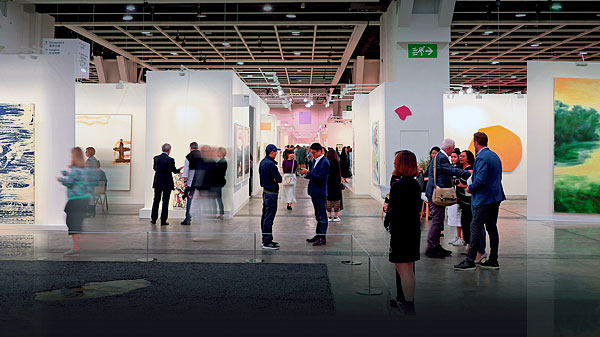While Hong Kong is known as an unsentimental global financial centre, recent years have seen a huge effort go into foisting a new image of the city – that of an international art hub – onto the sensibilities of the global public. At the forefront of this movement is Art Basel, the international art fair that has been an annual fixture in the city since 2013. As the only Asian iteration of this long-established Western art event, Art Basel Hong Kong attracts wide international attendance and participation from the world’s leading art galleries. This year, the event hit a new high, with 242 globally prestigious galleries taking part and a footfall in excess of 88,000.

Looking to capitalise on this success, a slew of other prestigious annual art events are now also using Hong Kong as a platform from which to jostle for their own share of the Asian art dollar, including Art Central, the Asia Contemporary Art Show and the Affordable Art Fair.
Running in parallel with this has been the city’s booming art auction scene – led by such luminaries as Sotheby’s and Bonhams – as well as its burgeoning number of blue-chip art galleries, notably Opera Gallery, K11 Art Foundation, Hanart TZ Gallery, Gagosian and White Cube. Among the more recent additions are H Queen’s in Central, an entire 24-storey building, and the South Island Cultural District, a whole urban zone – both dedicated to art and lifestyle.

Giving her own take on what is driving the local art boom, Adeline Ooi, the Asia Director of Art Basel Hong Kong, said: “What do you buy after your car and your Birkins and your LVs? The next thing was always going to be wine or art or – more likely – wine and art.”
But while Hong Kong has become a lucrative destination for those in the business of buying or selling art, those creating art don’t necessarily seem to be getting their share of the related profits. Their problems are, of course, only exacerbated by the burden of history. While the Post-Cultural Revolution period of the ’80s and ’90s triggered a renaissance of the mainland’s art scene – with the works of such artists as Zhang Xiaogang, Zeng Fanzhi and Yue Minjun becoming globally in demand – this also acted as a catalyst to eclipse the artistic endeavours of several generations of Hong Kong creatives.

Although some local artists (notably Lui Shou-kwan and Wucius Wong, founders of the New Ink Movement) did achieve international recognition from the ’70s onwards, most of their contemporaries have remained all but unknown. It’s a problem that continues to this day, with only one or two notable exceptions. So, while some high-profile figures – such as Lee Kit, who represented Hong Kong at the 55th Venice Biennale in 2013 – do get their due recognition, those who fail to secure the backing of the more affluent galleries still struggle to get by, with many of them obliged to move abroad.
One such struggling artist is Mona Choo, an artist who migrated to Singapore to boost her career. She says: “I was in a great exhibition in Hong Kong in 2016 – the One Belt, One Road Visual Arts Exhibition at Sotheby’s – and I made some great contacts. Despite that, I couldn’t find any Hong Kong gallery willing to work with me on a long-term basis.”

Many artists also complain that they have been driven out of the city by its exorbitant rents. One to fall victim to such a problem was Deniau, a French painter who tried to make a go of it in Hong Kong between 2014 and 2017. Ultimately despairing of finding an affordable place to work, she too quit the SAR in favour of Singapore. Comparing her current situation with her difficult Hong Kong years, she says: “Having a viable studio has made a huge difference to me. I am now far more productive than I ever was in Hong Kong.”
But there are others like French visual artist Ophelia Jacarini who, despite the many challenges, feel that Hong Kong’s burgeoning art scene may still have much to offer to budding artists. Says she: “Living here means being flexible. Though my studio is really small compared to the price I am paying, I feel like it’s still worth it as the art scene is growing here and I want to be part of it. Yes, If I compare it to Paris, I cannot spend time in a different museum every day to learn about various artists. Then there are such disappointments like shows or commission projects getting cancelled. But even then, I feel like I get more opportunity to share my work here than I did in Paris.”

This scope of “opportunity” is seemingly set to increase with Hong Kong’s 2018-2019 budget seeing a whopping HK$20 billion earmarked for artistic and cultural endeavours. Despite this apparent good news, though, some cynics have pointed out that only a small percentage of this figure will go towards supporting artists, with the lion’s share going towards building new cultural facilities and expanding existing ones.
This may seem a strange dichotomy but, in reality, it sums up just how art truly is perceived in Hong Kong – as a consumer-oriented commodity in a hyper-transactional space. As a result, many fear that, unless the city can find a way to bridge the gap between its creative and commercial imperatives, Hong Kong’s art scene may ostensibly continue to flourish, while its indigenous creative talents may wither away unacknowledged.
Text: Suchetana Mukhopadhyay
Image courtesy: AFP, Sotheby’s, Artify Gallery, Rogel Vidallo, Ophelia Jacarini



